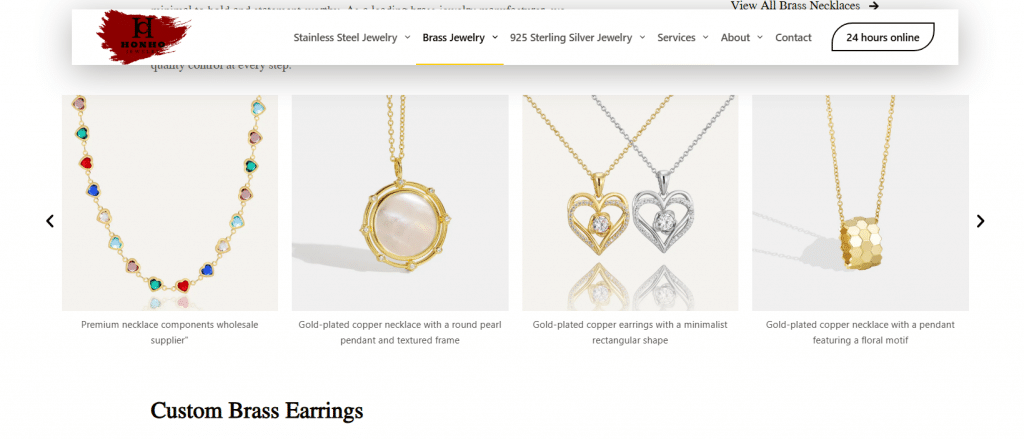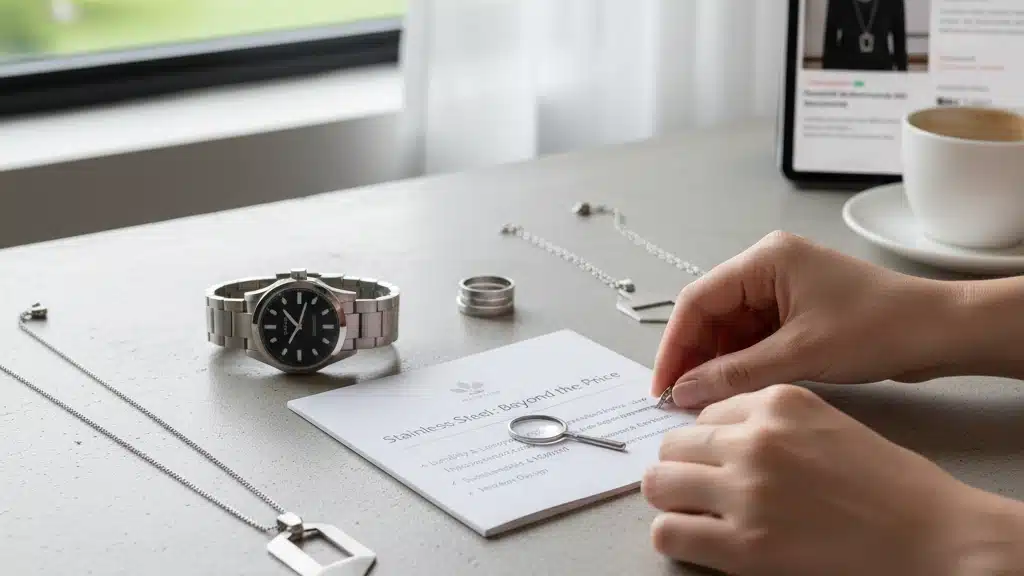Does Brass Jewelry Tarnish? Complete Guide to Prevention & Care


Although brass jewelry is nothing new, it seems to have gained a surge of popularity because its lustrous golden look comes at a much lower price point than solid gold jewelry. Now one question we get asked a lot at HonHo Jewelry is: “Does brass jewelry tarnish?” The short answer is yes, but there’s much more to know about why it occurs and how to stop it. In this complete guide, we will take a closer look at brass jewelry tarnishing — what causes it, how to prevent it, and how to fix it!
Why Does Brass Jewelry Tarnish?
Brass is mostly an alloy of copper (60-85%) with zinc (15-40%). And brass tarnishes because of its high copper saturation. Oxidation, a natural chemical reaction that occurs when brass is exposed to oxygen and moisture in the air, forms a layer of copper oxide on the surface.
The Science Behind Tarnishing

Tarnishing is not a sign of poor quality, but a natural chemical process. A darkened layer on your jewelry consists of copper oxide, which is formed when the copper in brass oxidizes in the presence of oxygen. This interaction is sped up by:
- Humidity and moisture: Environments with high humidity cause oxidation to occur faster
- Airborne pollutants: Sulfur compounds present in the air interact with brass to produce copper sulfide
- Skin chemistry: Your skin’s natural oils and acids can speed up tarnishing
- Chemical exposure: Lotions, perfumes and household cleaners contain compounds that react with brass
How Quickly Does Brass Jewelry Turn?
The rate of tarnishing varies greatly with different factors:
- Environmental conditions: Brass oxides faster in humid, polluted places
- Wear frequency: Daily worn jewelry likely to tarnish quicker, due to constant exposure to skin oils and environmental factors
- Skin chemistry: Those with more acidic skin pH typically see a faster tarnishing
- The faster tarnishing of brass with high copper content.
- Protective coatings: Brass with lacquer or sealant will tarnish more slowly
Brass jewelry that is not treated can show signs of tarnish after a few weeks to a few months of wear. But you can greatly prolong this period with proper care.
Understanding Tarnishing on Brass Jewelry
Tarnishing on brass jewelry occurs when the surface of the metal reacts with the environment, often resulting in a distinct greenish patina. This change can be attributed to the presence of copper in the brass alloy, which reacts with oxygen and moisture over time.
For some, this green layer adds a unique, vintage character to their jewelry, reminiscent of antique pieces that have elegantly weathered the passage of time. However, not everyone appreciates this aged look, as personal taste varies significantly. While some individuals embrace the rustic charm, others prefer their brass jewelry to maintain a shiny, polished appearance.
If you’re aiming to keep your brass jewelry looking new and lustrous, regular cleaning and proper storage in a dry, airtight environment can help slow down the tarnishing process.
Forms of Brass Utilized for Jewelry

Brass jewelry doesn’t all tarnish at the same speed. Various brass compositions and treatments influence the speed and extent of tarnishing.
Pure Brass vs. Plated Brass

Pure Brass Jewelry:
- Contains only copper and zinc
- Gains character with age (patina)
- Can be polished numerous times and shine up as new
- Usually more wear-resilient yet tarnishes more quickly
Brass-Plated Jewelry:
- Brass-Plated Jewelry:
- Built as a thin layer of brass over another metal
- This initial tarnishing may resist due to protective coatings
- May develop uneven tarnish once the plating has worn off
- Typically cheaper, but shorter-lived
Plating brass with precious metals like gold, silver, or rhodium can significantly enhance its durability. This process not only strengthens the jewelry but also prevents tarnish, keeping the piece looking pristine for longer periods.
Such plating options are particularly popular for items worn frequently, like bracelets, as they maintain their luster despite daily wear. By choosing metal plating, the jewelry not only gains an extra layer of protection but also benefits from the aesthetic appeal of the plated metal, making it both a practical and stylish option.
1. What types of jewelry benefit from this plating process?
Jewelry pieces such as bracelets, especially those worn frequently like Moissanite bracelets, benefit significantly from this process due to the added durability and tarnish resistance.
2. How does plating prevent tarnish on brass jewelry?
The use of precious metals in the plating process creates a barrier that helps protect the brass from environmental factors, thereby reducing the likelihood of tarnish.
3. How does plating affect the durability of brass jewelry?
Plating brass with metals like gold, silver, or rhodium provides an extra layer of protection, which enhances the overall durability of the jewelry.
Some Common Brass Alloys Used in Jewelry
- Yellow Brass (70% copper, 30% zinc): Most common jewelry metal, golden appearance
- Red Brass (85% copper, 15% zinc): warmer, redder sound and tarnishes faster
- White Brass (Contains nickel): A silvery color that tarnishes slower
- Naval Brass (contains tin): More resistant to corrosion, especially in marine environments

How to Store Brass Jewelry from Getting Tarnished

Though tarnishing will inevitably occur, there are some very effective techniques to help slow it down and keep your brass jewelry looking lovely for longer.
Daily Care Habits
- Avoid exposure to water: Remove your brass jewelry before taking showers, swimming, or washing your hands.
- Apply products first: Lotions, perfumes and cosmetics should be applied before your jewelry is put on
- Wipe after wear: After each wear, dab excess moisture and oils using a soft dry cloth
- Keep brass away from household cleaners, chlorine, and other harsh chemicals.
Proper Storage Techniques
Proper storage is key to preventing brass pieces from tarnishing when you’re not wearing them:
- Keep it dry: Store in a cool, dry place, away from bathroom dampness.
- Use anti-tarnish bags: These specialized pouches are lined with chemicals that absorb tarnish-causing compounds
- Silica packets: Store these dehumidifiers with your jewelry
- Keep each piece separate to avoid scratching and chemical reaction
- Small ziplock bags or airtight jewelry boxes
Protective Coatings
Protective Coatings
There are multiple defensive barriers that can really help make your brass jewelry shine last! A popular choice among jewelry enthusiasts and sellers alike is the use of protective coatings, such as clear lacquer or clear nail polish. These coatings serve as effective shields, preserving the beauty and longevity of your pieces.
Clear nail polish: Lightly cover them to create a temporary barrier (reapply every few months).
Clear lacquer offers a more permanent solution by providing a robust barrier against air and moisture. This not only keeps your brass jewelry looking vibrant and new but also enhances its durability, making it an excellent choice for high-demand items like bridal jewelry sets and copper rings.
For bulk buyers and retailers, offering pre-coated items can add significant value to your product line, attracting customers seeking durable and high-quality pieces. By incorporating these protective measures, you ensure your jewelry remains in pristine condition, delighting wearers and buyers alike.
1. What additional value can pre-coated items offer?
Pre-coated items are marketed as lower-maintenance options with increased durability, offering added value to both sellers and buyers.
2. What types of jewelry can be pre-coated with clear lacquer for added value?
Items like bridal jewelry sets and copper rings are ideal candidates for pre-coating, making them more attractive to customers.
3. Who might benefit from using clear lacquer on brass jewelry?
Bulk buyers and retailers can particularly benefit, as offering pre-coated jewelry items can enhance their product lineup.
4. How does clear lacquer protect brass jewelry?
Clear lacquer serves as a shield, preventing exposure to air and moisture, which are common contributors to the tarnishing of brass jewelry.
How to Clean Tarnished Brass Jewelry

Despite your finest preventive efforts, tarnishing will eventually occur. Here are the most efficient ways to bring the shine back to your brass jewelry:
Gentle DIY Cleaning Methods
For some light tarnish, give these gentle home remedies a try.
Paste of lemon juice and baking soda:
- Combine equal parts of lemon juice and baking soda
- Use a soft cloth to apply to jewelry
- Scrub lightly, then thoroughly rinse and dry
Vinegar solution:
- Combine equal portions of white vinegar and water
- Soak jewelry for 30 minutes (not advisable for those with gemstones)
- Make sure to rinse thoroughly and dry completely
Mild soap method:
- Combine some warm water with a few drops of gentle dish soap
- Gently scrub with a soft toothbrush
- Wash well and dry thoroughly
Cleaning Deeply for Significant Tarnish
For more stubborn tarnish:
1. Ketchup method:
- Spread ketchup over tarnished spots
- Let sit for 10-15 minutes
- Make sure to rinse well and thoroughly dry
2. Commercial brass cleaners:
- Follow product instructions closely
- Test on a small area first
- Then thoroughly rinse It after cleaning
3. Lemon and salt:
- Half a lemon with some salt on the open side
- Rub gently on tarnished areas
- Wash well and dry thoroughly
What to Avoid When Cleaning
Watch out for these common cleaning blunders:
- Abrasive cleaners: No scratchy scrubbing pads or rough powders
- Ultrasonic cleaners: May harm fragile brass parts
- Lengthy soaking: Long term exposure to liquids can cause harm to some brass jewelry
- Cleaning pieces with gemstone settings: Be particularly careful with pieces containing stones or a pearl
Can Tarnished Brass Jewelry Be Worn: Risk of Health?
Customers often wonder if tarnished brass jewelry is safe to wear. Here’s what you should know:
The “Green Finger” Phenomenon
The green spots that sometimes form on skin after wearing brass jewelry are caused by copper oxide moving onto your skin. This reaction:
- Generally harmless to most people
- Easily removable with soap and water
- Can be avoided with the use of protective coatings
- Becomes more intense, or mellows depending on your skin chemistry
Allergic Reactions
- Allergic reactions to brass components may occur in some individuals:
- Zinc allergy: Uncommon but conceivable
- Nickel: Nickel is a common allergen, and some brass alloys include nickel.
- Symptoms: Redness, itching or rash where jewelry touches skin
- Solution: Look for higher-grade brass or hypoallergenic options
Why Brass Jewelry is Great Even If It Does Tarnish

At HonHo Jewelry, we think brass jewelry has so many benefits that overshadow the small negative of the jewelry tarnishing:
Brass offers a warm, golden hue that beautifully mimics the look of pure gold. This makes it an appealing choice for jewelry enthusiasts who desire the opulence of gold without the hefty price tag. Its gold-like appearance is perfect for crafting statement pieces like Moissanite bracelets, as well as everyday essentials like wholesale earrings, providing the allure of luxury at an accessible cost.
- Pretend: The gold look without the cost
- Why it’s great: Goes with nearly every look or outfit
- Durability: More durable than most precious metals
- Sustainability: Greener than precious metals, whose mining is energy intensive
- Character: Most people love the vintage look that comes from years of use
- Customization: Can be shined to a polish or scratched up for that vintage look
Brass’s versatility doesn’t stop at appearance. It seamlessly blends with various styles, making it a flexible choice for any wardrobe. Additionally, its durability surpasses that of many precious metals, ensuring that each piece stands the test of time.
Consider the environmental benefits too—brass is a more sustainable option compared to the energy-intensive mining of precious metals. Over time, its patina develops into a charming vintage look, adding unique character that many jewelry lovers cherish. Plus, whether you prefer a polished shine or a rustic finish, brass can be easily customized to suit your personal style.
What You Need to Know About Brass Jewelry Tarnishing FAQs

How long until brass jewelry becomes tarnished?
Depending on environmental conditions, skin chemistry, and care habits, untreated brass jewelry will start to show signs of tarnish generally within a few weeks to a couple of months of normal wear.
Is the green stain from brass jewelry toxic?
No, the green line that sometimes appears on the skin from wearing brass jewelry is harmless copper oxide and can be washed away easily with soap and water. It’s not an indicator of costume jewelry or something to worry about health-wise.
How do I take care of my brass jewelry?
It’s not recommended. Water — hot water, especially soapy hot water or chlorinated water — speeds up tarnishing. For a longer-lasting shine, remove brass jewelry before showering, swimming or washing your hands.
How to Tell If Your Jewelry Is Brass or Gold
Brass weighs more than gold-plated jewelry and less than solid gold. Check for markings (actual gold will be marked with karat value). Brass will have a softer tone than gold and will tarnish over the years, and gold won’t.
Does brass jewelry turn your skin green?
Not necessarily. Making skin green varies by the specific composition of brass, your specific skin chemistry, and if the brass has been treated with a protective coating. This reaction occurs in higher degrees for some than others.
Can tarnished brass jewelry be restored to its original shine?
The answer is yes, tarnished brass can usually be cleaned up to look like new. However, extremely neglected pieces, or those with decorative antiqued finishes, may prove challenging to restore fully.
How to Use Polishing Cloths for Brass Jewelry Maintenance
Polishing cloths are an essential tool for keeping brass jewelry looking its best. Here’s how you can use them effectively to maintain the luster of your favorite pieces:
- Choose the Right Cloth: Opt for a soft, non-abrasive polishing cloth specifically designed for metals. These cloths are gentle enough to clean brass without scratching its surface.
- Regular Polishing Routine: Make it a habit to routinely polish your brass jewelry. This regular maintenance helps in preventing tarnish build-up before it becomes visible.
- Tarnish Removal: If you notice any tarnish, a polishing cloth can easily handle it. Gently rub the affected area until the tarnish lifts, revealing the shine underneath.
- Versatile Use: Whether you have beaded bracelets, statement necklaces, or detailed earrings, polishing cloths are versatile and can be used on various types of brass accessories without damage.
- Post-Cleaning Care: After polishing, store your jewelry in a dry, cool place to minimize exposure to elements that contribute to tarnishing, enhancing the lifespan of your brass treasures.
Incorporating polishing cloths into your jewelry care routine ensures that your brass pieces remain just as brilliant as the day you first laid eyes on them.
Related Posts

Understanding Wholesale Jewelry Pricing and How It Works
Understanding Wholesale Jewelry Pricing and How It Works When people see a ring that costs $6 wholesale and retails for $59, they often

The Art of Shine in Jewelry Polishing and Plating Techniques
Discover how polishing and plating transform modern jewelry with expert techniques for lasting shine and elegant finishes.

Τι Νοιάζει Πραγματικά τους Αγοραστές Ανοξείδωτου Κοσμήματος Εκτός από την Τιμή
Τι πραγματικά νοιάζει τους αγοραστές ατσάλινων κοσμημάτων πέρα από την τιμή ανθεκτικότητα υποαλλεργικά υλικά και μοντέρνο στυλ.
